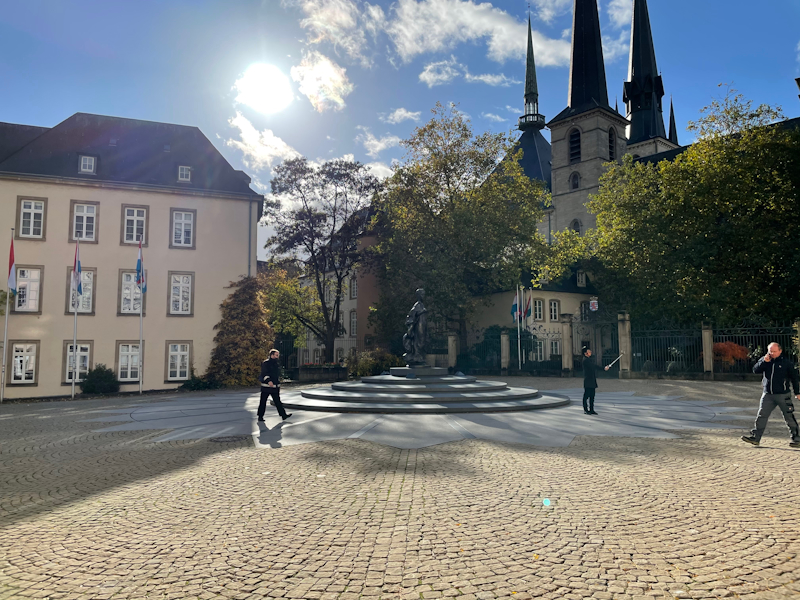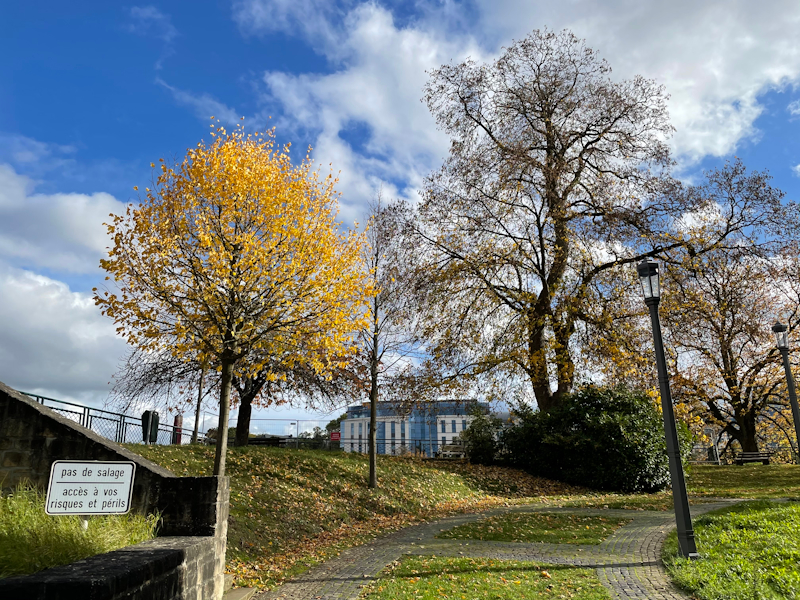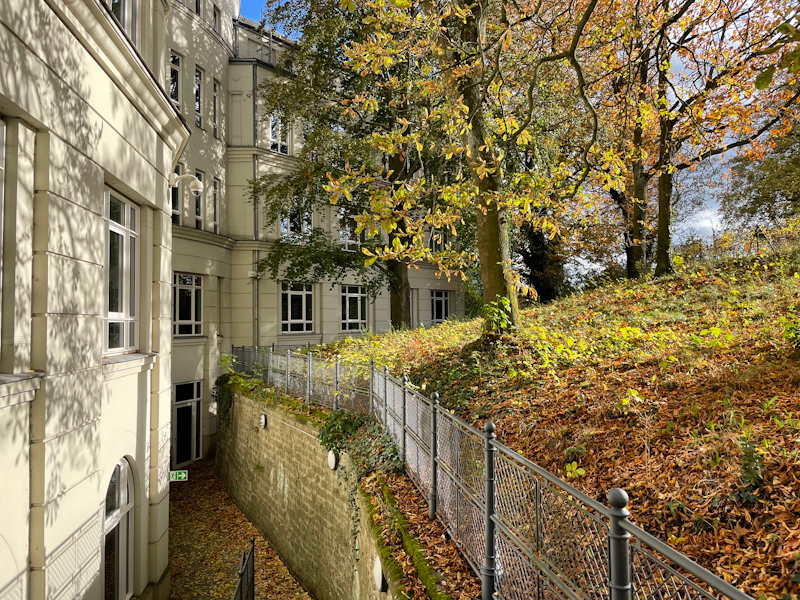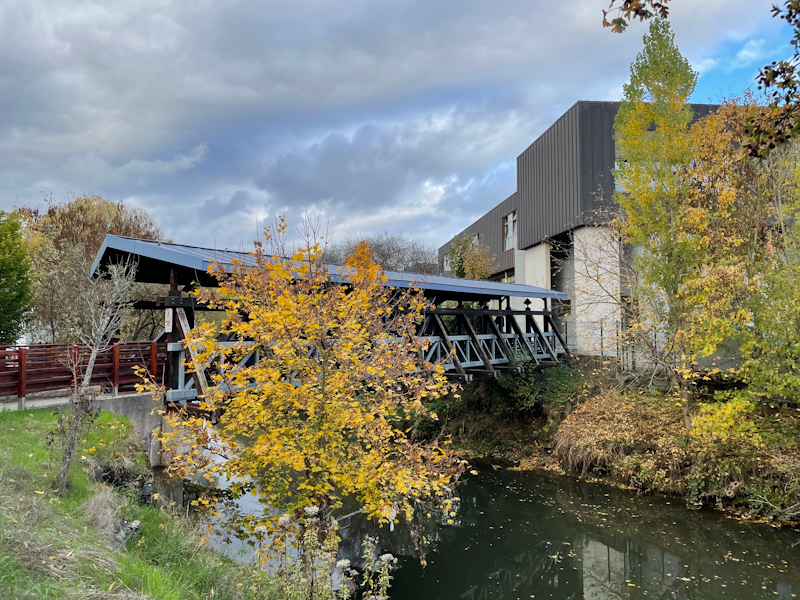The iPhone 12 & 12 Pro Review: New Design and Diminishing Returns
by Andrei Frumusanu on November 30, 2020 8:30 AM EST- Posted in
- Mobile
- Apple
- Smartphones
- Apple A14
- iPhone 12
- iPhone 12 Pro
Camera - Daylight Evaluation
The iPhone’s 12 and 12 Pro’s camera setup we’re reviewing today isn’t very exciting when looking at the paper specifications. Compared to the iPhone 11 Pro, the 12 Pro’s only real change is a new optics system on the part of the main camera, increasing the aperture from f/1.8 to f/1.6. The telephoto module and ultra-wide angle both remain seemingly the same at 12MP f/2.0 at 52mm equivalent, and 12MP f/2.4 at 13mm equivalent.
Where things might have changed more substantially is on the software processing side of things, where Apple has promised new improved HDR algorithms, enabled by the new processing power of the A14 SoC.
We’re limiting the comparison pictures here to the iPhone 12 Pro, with the iPhone 12 of course lacking the telephoto module but otherwise having identical hardware, the iPhone 11 Pro, as well as the latest Samsung flagship in the form of the Note20 Ultra, and S20+, as well as a Pixel 4 for the daylight pictures.
I’m including a Fujifilm X-T30 mirrorless ILC with an 18-55mm f/2.8-4 as a reference camera for the sake of colour accuracy comparisons. The shots here have been edited for dynamic range recovery and my best effort reproduction of the actual scenes.

[ iPhone 12 Pro ] [ iPhone 11 Pro ]
[ Note20 Ultra (S) ] [ S20+ (E) ]
[ Pixel 4 ] [ X-T30 ]
In this first scene I tried a worse-case scenario for the phones, shooting a contrasty scene against the sun, fully stressing the HDR algorithms of the cameras as well as the optics.
The new iPhone 12 Pro’s main camera doesn’t change the composition and exposure of the scene all too much compared to the iPhone 11 Pro, however we do see quite a bit better contrast. The sky’s discoloration around the sun is also less pronounced than on the iPhone 11 Pro, both signs that the new optics are of a high quality.
On the ultra-wide angle, we’re also seeing improved contrast – given that the hardware looks to be the same this would rather point out to an improved handling of HDR processing on the part of the new phone.

[ iPhone 12 Pro ] [ iPhone 11 Pro ]
[ Note20 Ultra (S) ] [ S20+ (E) ]
[ Pixel 4 ] [ X-T30 ]
The weather was quite cloudy during the shooting of these scenes but I tried my best to capture consistent shots between the phones. What’s immediately noticeable across all the shots of the new iPhone 12 Pro versus the 11 Pro is that while colours and general exposure is similar, the 12 produces higher contrast results which pop out more than on the predecessor.
On the telephoto module, oddly enough it feels as if things aren’t quite as detailed on the new phone as we’re seeing a HDR-like smudging of fine details such as the foliage and roof tiles of the scene. The main cameras are about the same, while on the ultra-wide angle I’d actually say the 12 Pro is able to preserve more details.

[ iPhone 12 Pro ] [ iPhone 11 Pro ]
[ Note20 Ultra (S) ] [ S20+ (E) ]
[ Pixel 4 ] [ X-T30 ]
In this next scene you’d be hard-pressed to differentiate the new iPhone. The only real difference on the part of the main camera I’m seeing are actually less defined shadows compared to the iPhone 11 Pro.
On the ultra-wide module, things change more dramatically, with much better detail retention on the new phone. Here we’re also seeing a large change in perspective correction between the two generations, especially in the corners of the image.
Compared to the competition, Apple doesn’t fare as well in terms of details as the Samsung phones are able to retain quite significantly more finer details throughout the scene while the iPhones seem to be smudging things out through the processing. Samsung’s HDR on the ultra-wide is also able to retain a better dynamic range, with more details in the shadows having been preserved.

[ iPhone 12 Pro ] [ iPhone 11 Pro ]
[ Note20 Ultra (S) ] [ S20+ (E) ]
[ Pixel 4 ] [ X-T30 ]
In this next scene it’s again visible that the new phone is able to showcase higher contrast levels. One thing that I don’t like very much on the Apple phones or the Pixel is the colour temperature which is quite too warm for this scene, being quite inaccurate compared to the real scene at the time and what the Fuji was able to capture. The Samsung phones aren’t quite as off and the best amongst the phones here.

[ iPhone 12 Pro ] [ iPhone 11 Pro ]
[ Note20 Ultra (S) ] [ S20+ (E) ]
[ Pixel 4 ] [ X-T30 ]
This is also a scene where the colour temperature of the new iPhone 12 seems to have gotten worse, being far too warm again compared to the actual scene as well as warmer than the 11, with the Samsung phones being far better in that regard.
HDR processing is much improved, especially noticeable on the ultra-wide of the new iPhone which retains a lot more details and handling of tones.

[ iPhone 12 Pro ] [ iPhone 11 Pro ]
[ Note20 Ultra (S) ] [ S20+ (E) ]
[ Pixel 4 ] [ X-T30 ]
Here again, the 12 produces a warmer picture than the 11, and veers off further away from the actual colour of the scene.
Apple opted to retain a traditional telephoto module setup on the new iPhone 12 Pro; what’s odd here is that again we’re seeing worse detail retention compared to the 11 Pro even though the hardware should in theory be the same.
This is especially visible when you have to user higher digital zooming, as the 5x magnification of the iPhone 12 Pro looks to me considerably worse than the 11 Pro. It’s as if there’s a heavy layer of noise reduction applied to the new phone’s camera processing on this new module.
Naturally, the 2x optical module can’t compete against some of the newer, more exotic camera solutions such as on the Note20 Ultra, but even the S20+’s 64MP unit using cropping and digital zooming vastly outperforms the telephoto module of the iPhone.

[ iPhone 12 Pro ] [ iPhone 11 Pro ]
[ Note20 Ultra (S) ] [ S20+ (E) ]
[ Pixel 4 ] [ X-T30 ]
This scene is a more noticeable improvement for the iPhone 12 Pro, with better HDR tone mapping as well as a better, more accurate colour temperature, although it’s still quite far off from reality, closest matched by the Note20 Ultra which has a near perfect reproduction.

[ iPhone 12 Pro ] [ iPhone 11 Pro ]
[ Note20 Ultra (S) ] [ S20+ (E) ]
[ Pixel 4 ] [ X-T30 ]
This last scene didn’t have a very high dynamic range as it was getting almost fully overcast; the new iPhone 12 behaved quite weirdly in terms of exposure of the foliage, as it lost saturation and is far too grey compared to the more accurate iPhone 11 shot. The Pixel 4 here had the best reproduction of the actual scene in terms of exposure and colours.
Daylight Conclusion: Better HDR, in Some Situations
Overall, the iPhone 12’s biggest changes in daylight captures can be summed around the fact that it has a new HDR algorithm, that in the majority of cases, produces better and higher contrast results. On the main camera, it’s a general positive although there’s a few scenes where for some reason the iPhone 12 processing fared off worse in terms of colour temperature and colour accuracy. Although the iPhone 12 performed well here overall, the main camera didn’t handle things as detailed or as accurately as the Note20 Ultra.
The ultra-wide angle seems to be universally improved this generation and that’s a much welcome change for the new devices: it showcases much better detail retention as well as better HDR processing. It’s still not quite at the same level as Samsung’s unit here but it’s much closer than before.
What’s quite disappointing on the new iPhone 12 Pro is the telephoto module. I felt that it universally was worse off than the 11 Pro due to the fact that it just couldn’t match the detail retention of its predecessor. I think this may be due to the new HDR processing that merges subsequent captures together. In any case, it doesn’t hold a candle to the competitions telephoto solutions which are significantly superior in hardware capabilities.










101 Comments
View All Comments
anshelanancy - Wednesday, December 2, 2020 - link
This iPhone 12 is really well designed but high cost and released in some countries normally we can buy it online. I want to buy this but it isn't released in my country. I must buy this phone but this time I am so much busy with my office work https://accountancyseekers.co.uk/ here doing work as a marketing executive since 2017.Byte - Tuesday, December 15, 2020 - link
I kept my X to play games on and found it hurts to hold the X now because the the whole side feels sharp now. Am i weird?Laga Goteborg - Thursday, June 24, 2021 - link
iPhone 12 LCD screens are much tougher than before, we had cases that glass was intact but LCD under glass was shattered. However we could always fix the problem via https://www.LagaiPhone.se/KPOM - Monday, November 30, 2020 - link
The 12 mini hits the sweet spot for design and features this year, and I’m surprised it isn’t selling better (apparently Apple is seeing more demand than expected for the Pro and Max and somewhat less for the 12 and mini).I agree that the 12 Pro is a bit heavy and the new design isn’t as easy to hold as the 11 Pro. But the mini is only slightly bigger than the original iPhone SE/5/5s, and is the most comfortable phone to hold that I’ve seen in years.
Bob Todd - Monday, November 30, 2020 - link
I assume some of it is just that people have gotten accustomed to gargantuan phones over time and it can be a bit of a shock to scale back down. After holding the 12 mini in one hand and my OnePlus 6 in the other, I was certainly hesitant to give up that much screen. It was mostly fond memories of my Essential Phone's form factor that pushed me to choose the mini. My wife on the other hand is eyeing the regular 12 for this exact reason. She's accustomed to the size of her OnePlus 7T and the progressively larger phones that have landed her there.lmcd - Tuesday, December 1, 2020 - link
I personally think that it's due to upgrade cycle timing -- why buy a 12 mini if you just bought an SE 2020?I think a lot of people in that niche picked up an SE and also are already the type to hold onto their phones longer.
techconc - Monday, December 7, 2020 - link
Agreed. I have the 12 Pro, but after feeling the 12 mini in my hand (and in my pocket), I think I may go mini next time.ikjadoon - Monday, November 30, 2020 - link
The Mini is limited to 12W peak MagSafe, unlike “up to 15W” on all the other models.https://support.apple.com/en-us/HT211829
Jetcat3 - Monday, November 30, 2020 - link
12W peak with a 2227 mAh cell is non issue in my opinion.Andrei, in your testing did you notice increased black levels with low APL’s at brightness levels between 0-40%?
ikjadoon - Monday, November 30, 2020 - link
I don't think a single person genuinely cares or notices peak charging rates: minutes at best? Though the first page chart is a little incorrect.On displays, I'd be much more interested in power consumption of the two panels, so we can compare with the 11 Pro.